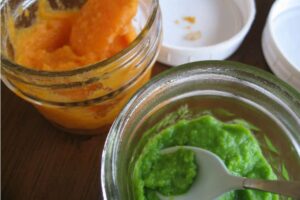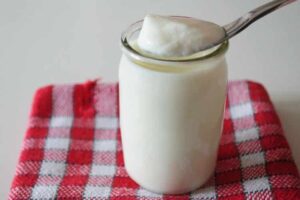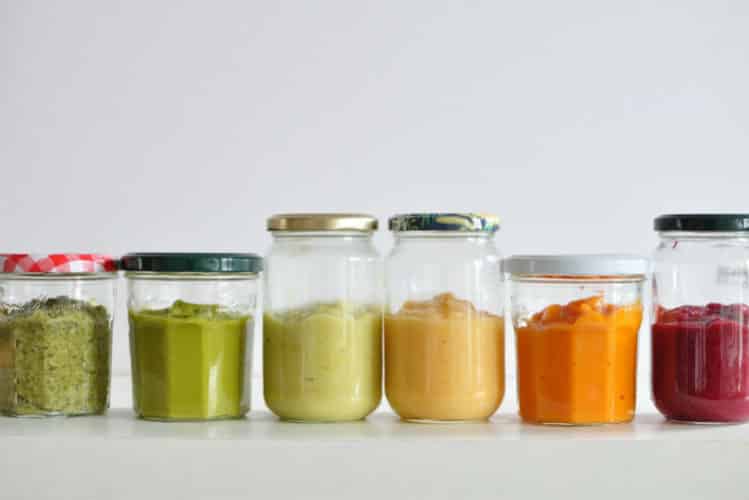To learn more about purées, see the start of the entry: Everything About Homemade Baby Purées.
Many differences between homemade and store-bought purées exist. Ingredients used for making purées are directly related to their nutritional value. The fresher the food, lower levels of processing, the richer the ingredients will be in nutrients for the growing baby!
Homemade Purées
When you make your purées, you know what they contain. The ingredients are usually fresher, more nutritious and tastier. It also costs less to make purées rather than buying them. Finally, they don’t contain additives or preservatives.
Additionally, Mélissa, our nutritionist, compared the nutritional value of homemade purées with store-bought purées and found that homemade ones were three times higher in energy, protein and iron, essential elements for your baby’s growth.
 It’s interesting to note that homemade purées allow you to change textures to meet the growing needs of your baby. When preparing them, it’s easy to make them thicker or chunky based on your baby’s chewing capacity. Additionally, the variety offered at home is better, because you can offer them avocados, mangoes, pineapples, bananas, legumes and eggs.
It’s interesting to note that homemade purées allow you to change textures to meet the growing needs of your baby. When preparing them, it’s easy to make them thicker or chunky based on your baby’s chewing capacity. Additionally, the variety offered at home is better, because you can offer them avocados, mangoes, pineapples, bananas, legumes and eggs.
Certain fresh foods, such as avocados, bananas, mangoes, papayas, cantaloupes, watermelon and pineapple won’t even need to be cooked before being puréed for your baby. You won’t even need the blender for an avocado or banana, which can be crushed with a fork and given to the baby. Given these last two foods oxidise with exposure to air, you shouldn’t freeze them as they will blacken easily, and the texture may be unpleasantly surprising if you get my meaning! 😊
Canned food can also be used. However, it’s been processed and often has added salt and additives. There’s less vitamin C because they have already been heated to be canned. The food may oxidise when heated to purée it, which reduces its nutritional value even more.
Due to this, if you can choose frozen foods which were quickly packaged after harvest, it’s a better choice than canned foods.
Store Bought Purées
Using store-bought purée saves parents time, as they’re both practical and fast. It’s okay to use them as a time saver occasionally.
Store-bought purées can taste very good, sometimes they’re organic, and some resemble homemade purées, except for the price, of course.
However, for most brands, the purées often contain food additives such as flour (to thicken), starch, cream and often added sugar.
Added sugars have a variety of names—dextrose, sucrose, maltose, glucose, fructose, syrup and sometimes, even honey. Jarred purées often have these additives to make them smoother, thicker, sweeter, more esthetic and stable for their colour, which is fine up to a point!
Sometimes, a baby will reject a homemade purée if they have tasted store-bought versions, as they’re often more homogenous and have a sweeter or saltier taste, smoother texture than homemade ones. I suggest you taste the purées you give to your baby. You will note that meat and vegetable purées leave a lot to be desired…well, at least for my taste! 😊
That said, always verify the ingredients found in the purée to guide your purchases. The main ingredients are often the food itself and water. Also, you should note that mixed store-bought purées, which contain meat and a vegetable, contain very little meat and as such little iron compared to the portion of vegetables included. If you choose to feed your baby with store-bought jars, you should buy jars of meat separately from jars of vegetables and make your own mixes. This way our young one gets the iron they need for their body and growth.
Purées labelled Junior are made with pieces of food, are thicker and are for older children. This helps them eat different textures and evolve them towards eating what you eat at the table as a family.
 Concerning dairy products, it’s recommended that you offer cheese or yogurt only when the baby eats foods rich in iron at least twice a day. This is because, consumed in a large quantity, dairy products hinder iron absorption. Cow milk can be introduced between 9 and 12 months.
Concerning dairy products, it’s recommended that you offer cheese or yogurt only when the baby eats foods rich in iron at least twice a day. This is because, consumed in a large quantity, dairy products hinder iron absorption. Cow milk can be introduced between 9 and 12 months.
Based on the age when you start introducing solids to your baby, say 4-6 months, purées must be smoother to allow them to transition from liquids to solids. As your baby gets older, the textures should become thicker. Then at around nine months introduce pieces of food so that they eat the same thing as the rest of the family.
Even if your baby doesn’t have teeth, they can chew different textures of purées or even small pieces of food with their gums. Their gums harden over time.
To read the rest of the entry, go to Allergens and Possible Reactions.


